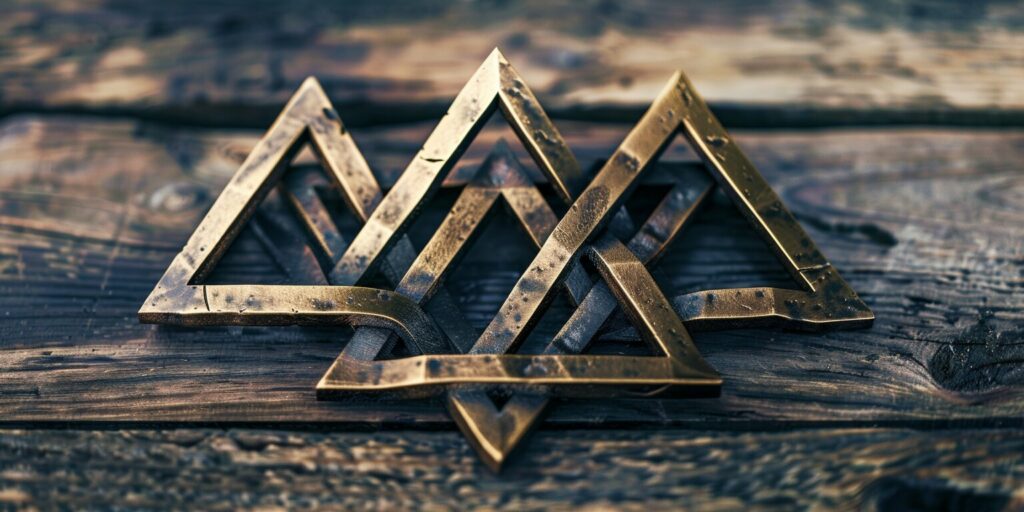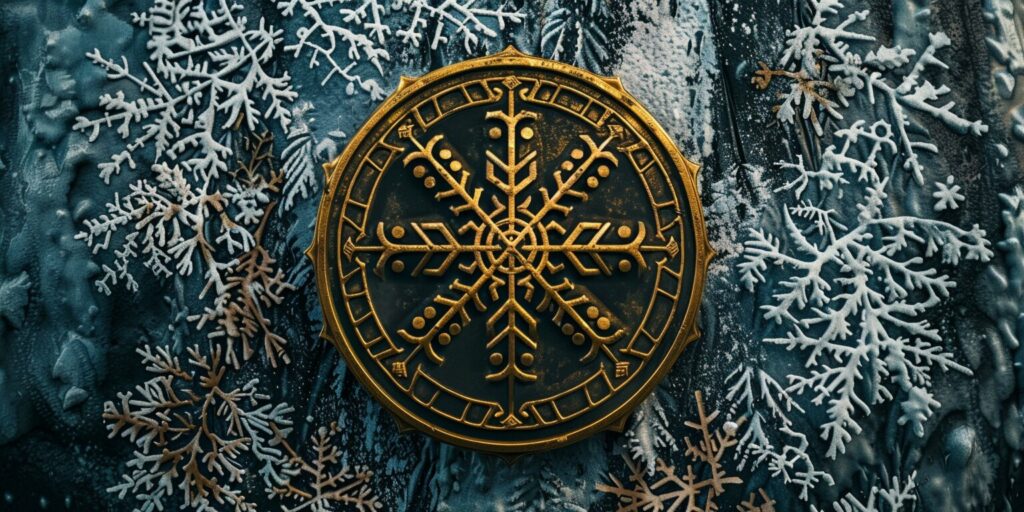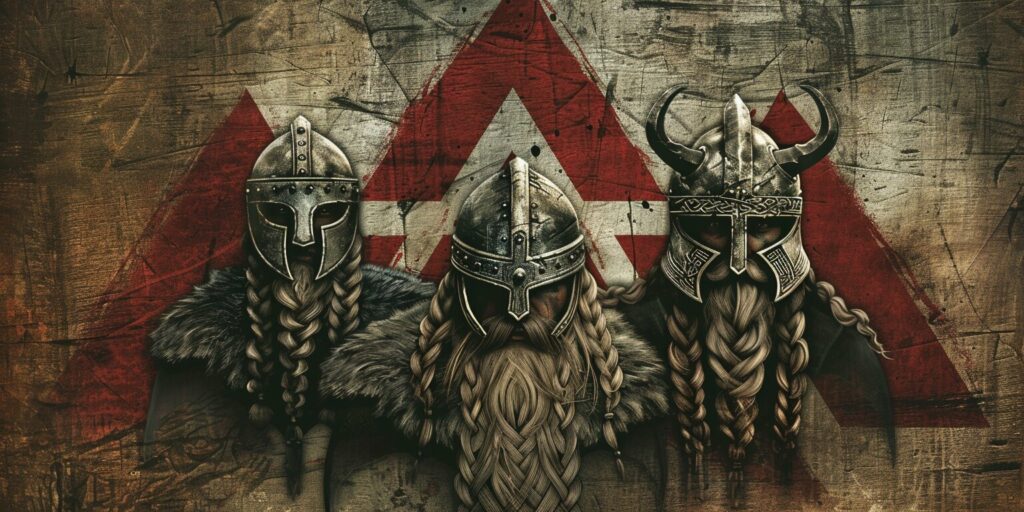Norse Symbols, Tales of the Gods, Vikings
Warrior Marks: The Deep Meanings Behind Viking Warrior Symbols
Welcome to a journey into the fascinating world of Viking warrior symbols and meanings. These ancient Norse markings hold profound significance and reveal the legends and beliefs that fueled the mighty Viking warriors. In this article, we will explore the rich history and symbolism behind these iconic warrior symbols, shedding light on their significance in Viking culture.
Symbolism in Viking Culture
In Viking culture, symbols held deep significance and played a crucial role in the lives of Viking warriors. These symbols represented their values, beliefs, and achievements, serving as powerful reminders of their warrior ethos.
The Viking warrior symbols were intricately designed and adorned these legendary warriors’ shields, weapons, and clothing. Each symbol conveyed specific meanings and acted as a source of inspiration and protection.
For the Vikings, the viking symbol for warrior represented not only physical strength and combat prowess but also the warrior’s connection to the divine and the battle spirit that dwelled within. These symbols were a source of spiritual guidance and strength in the face of challenges and conflicts.
The Role of Symbols in Viking Society
Symbols in Viking culture served various purposes. They could denote a warrior’s allegiance to a particular tribe or clan, emphasizing their unity and loyalty. These symbols also conveyed familial ties and acted as genealogical markers, signifying a warrior’s proud lineage and heritage.
Furthermore, Viking warrior symbols were used to invoke divine protection and provide spiritual guidance in battle. They were believed to ward off evil spirits, instill fear in enemies, and inspire bravery and courage in the heart of the warrior.
These symbols were not limited to physical objects but were also etched into runestones and depicted in intricate carvings on longships and other structures. They served as a visual language, preserving the stories and legends of the Viking warriors for future generations.
In conclusion, the Viking warrior symbols held deep meanings and were integral to Viking culture. They represented the warriors’ values, achievements, and spirituality as powerful reminders of their warrior ethos. Their significance went far beyond mere decoration, leaving a lasting impact on Norse history and culture.
Common Viking Warrior Symbols
In Viking culture, symbols held immense significance and were prominently displayed on warriors’ shields, weapons, and clothing. These symbols served as decorative embellishments and conveyed powerful meanings that represented the valor and prowess of Viking warriors in battle.
So, what is the Viking symbol for warrior? One such symbol is the Valknut, which is often associated with fallen warriors. This intricate knotwork design features three interlocking triangles, symbolizing the connection between life, death, and the afterlife. The Valknut was believed to grant protection and guidance to warriors in the heat of battle, ensuring their safe passage to the warrior’s paradise, Valhalla.

Another common symbol among Viking warriors is the Mjölnir, the mighty hammer of the thunder god, Thor. This symbol represented strength, protection, and the ability to defeat enemies. Carrying or wearing Mjölnir was believed to invoke Thor’s blessings and imbue the warrior with his legendary power. The symbol was often carved into amulets or depicted on shields and helmets.
The Ægishjálmr, also known as the Helm of Awe, was another frequently utilized symbol by Viking warriors. This eight-armed geometric symbol was believed to possess magical properties, instilling fear and confusion in the hearts of enemies. Warriors would paint or carve this powerful symbol on their foreheads or helmets, relying on its protective capabilities to ward off harm in combat.
Furthermore, the mighty tree that connected the realms in Norse mythology, the Yggdrasil, was considered a symbol of life, wisdom, and the interconnectedness of all things. Viking warriors regarded this symbol as a reminder of their place in the cosmic order and drew inspiration from it in their quest for glory and honor on the battlefield.
These are just a few examples of the many Viking warrior symbols that held deep meanings for the Norse warriors. Each symbol served as a reminder of their courage, resilience, and indomitable spirit. Through these symbolic representations, the Viking warriors honored their heritage, expressed their identity, and instilled fear in the hearts of their adversaries.
The Helm of Awe: A Viking Symbol for Warrior Protection
The Helm of Awe, also known as Ægishjálmr, is a powerful Viking symbol that held great significance for the Norse warriors. This intricate design, resembling a circle with intersecting lines radiating outward, symbolized protection and strength in battle.
The Helm of Awe was believed to have the power to strike fear into the hearts of enemies and provide courage and resilience to the wearer. It was a symbol of invincibility, warding off evil and protecting the warrior from harm.
According to Norse mythology, the Helm of Awe was crafted by the god Odin, who possessed great wisdom and knowledge. Viking warriors would often inscribe this symbol on their foreheads or helmets before going into battle, invoking the protective powers it embodied.
This symbol’s spiritual significance was closely linked to Viking beliefs and superstitions. It was thought to create a mystical aura around the warrior, intimidating adversaries and enhancing their combat abilities.

The Helm of Awe’s intricate design reflects the complexity and depth of Viking spirituality. Each line and intersection held its own meaning, representing the interconnectedness of the warrior’s mind, body, and spirit.
The Helm of Awe is a testament to the Viking warrior’s dedication to their craft and unwavering courage in the face of adversity. Its enduring symbolism continues to inspire and captivate modern audiences, representing the indomitable spirit of the Viking warrior.
Valknut: The Knot of Fallen Warriors
In Norse mythology, the Valknut is a powerful symbol connected to fallen warriors. Represented by three interlocking triangles, this complex emblem has fascinated historians, archaeologists, and enthusiasts alike. The Valknut holds deep significance in Viking culture, reflecting the warrior ethos and the cycle of life and death.
There are several interpretations of the Valknut’s meaning. One theory suggests that the symbol represents Odin, the Norse god associated with war, wisdom, and death. As the ruler of Valhalla, Odin welcomed fallen warriors into his sacred hall, making the Valknut a potent symbol of the afterlife and eternal glory.
The Valknut’s three intertwining triangles can also be seen as a representation of the three realms: Asgard (the realm of the gods), Midgard (the realm of humans), and Helheim (the realm of the dead). This interpretation emphasizes the symbol’s connection to the cycle of life, death, and rebirth, illustrating the bravery and sacrifice of Viking warriors on the battlefield.
The Valknut is often found on ancient Viking tombstones, suggesting its association with the commemoration and remembrance of fallen warriors. In addition, the symbol is sometimes depicted alongside ravens, which were believed to guide fallen warriors’ souls to Valhalla.
Symbolic Significance
- Honor and Sacrifice: The Valknut represents the valor and bravery demonstrated by Viking warriors in battle. It symbolizes their willingness to sacrifice their lives for their people, ensuring their place in Valhalla.
- Eternal Connection: The interlocking triangles of the Valknut signify the continuous bond between the living, the dead, and the gods. It serves as a reminder of the eternal connection between fallen warriors and the divine realm.
- Protection and Guidance: The Valknut is believed to offer protection to those who wear or bear it, serving as a talisman to ward off harm and provide guidance in times of danger.
Today, the Valknut continues to inspire fascination and respect for the warrior spirit. Its intricate design and profound symbolism demonstrate the enduring legacy of Viking culture and the indomitable spirit of the Viking warriors.
Conclusion
As we conclude our journey into the deep meanings behind Viking warrior symbols, we are reminded of the rich symbolism that defined the lives of these legendary warriors. The Viking warrior symbols and their meanings were not merely decorative, but rather, they represented the core values and beliefs of the Norse people in times of war and conquest.
The Vikings’ relentless warrior spirit is exemplified in the powerful viking symbol for warriors, a reminder of their courage and strength in battle. These symbols adorned their shields, weapons, and clothing, serving as a visual representation of their combat prowess and bravery. Each symbol held its own unique significance, showcasing the achievements and triumphs of the viking warriors.
From the Helm of Awe, a symbol of protection and invincibility, to the intricately woven Valknut, symbolizing the fallen warriors, these viking warrior symbols became ingrained in Norse history and culture. They served as a source of inspiration for the Vikings themselves and continue to captivate and intrigue us even today.
So, next time you come across a Viking symbol, take a moment to reflect on its profound meanings. Let these ancient symbols connect you to the fierce and resilient spirit of the viking warriors, who left an indelible mark on history.

